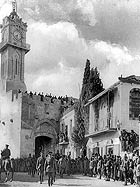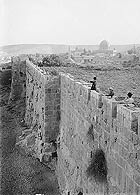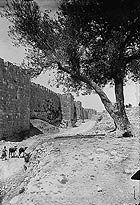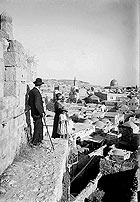The Time of the British Mandate, 1917-1948
|

|
Before we begin the survey of the Mandate period one should mention some of the British researchers who were already involved in the study of ancient Jerusalem from the end of the nineteenth century. The Ottoman authorities authorized the undertaking of excavations in Jerusalem but absolutely prohibited excavations on the Temple Mount and in its mosques. Researchers from the Palestine Exploration Fund conducted probes in the southeastern corner of the city wall and excavations in the Upper City (in what is today Mount Zion) where they uncovered remains of a wall and evidence of gates.
On December 11, 1977 Gen. Allenby entered the Old City of Jerusalem by way of Jaffa Gate. His entry symbolizes the beginning of the British Mandate in Jerusalem, a period during which the city experienced development and considerable growth and its image, which we are so familiar with today, was shaped then. The British ascribed great importance to maintaining the character of Jerusalem and its uniqueness as a city holy to the three religions. At the same time town planning and maintaining the architectural character of the city were greatly stressed. The British governmental institutions were concentrated in the city and they greatly influenced Jerusalem's urban development.
The British prepared a number of master plans for Jerusalem from 1918 onwards (MacLean's master-plan) that focused on the Old City and its importance to the three religions. The aim of the plans was to maintain the Old City's appearance while establishing directives regarding limitations on the height of construction, construction style and the allocation of open spaces in the city and its surroundings, etc.
One of the people who influenced the design of the city and safeguarded its character was Ronald Storrs who was appointed governor of Jerusalem when the city was conquered (military governor from 1918-1920 and civilian governor from 1920-1926).
Sir Ronald Storrs founded the Pro Jerusalem Society, which he called "a kind of urban and aesthetic council beside the military governor". The society's budget was derived from the military governor's funds and afterward from the civilian governor's funds, as well as from contributions.
The society's goal was the maintenance of Jerusalem which included: treating and repairing parts of the Old City wall and the Dome of the Rock; cleaning the Citadel (David's Tower), exposing archaeological finds and turning it into a center for presenting the Land of Israel and art, while embodying its tourism potential; cleaning and rehabilitating the marketplaces in the Old City; removing the Turkish clock that stood next to Jaffa Gate (which was erected at the beginning of the twentieth century); planting trees and creating parks around and inside the Old City (e.g. the modest park in the Jewish Quarter) and a park in the Citadel moat.
These were the very first steps that were taken and some of them were manifested in later plans such as encircling the city wall with a park which was only implemented after 1967. In addition to these measures at the time of the Mandate the British executed other changes in the wall and its gates such as breaching the inner part of Lions Gate and preparing it for motor vehicle traffic in order to make it easier to enter the Old City and reach the Via Dolorosa.
In his role as military governor, Storrs published three "thou shall not" decrees on April 8, 1918, which determined the appearance of the city today:
- A ban on destroying buildings and making changes in them unless permission for this was granted by him in writing
- A ban on using stucco and iron sheeting for covering the walls of buildings; he ordered that all buildings be made of stone
- A ban on hanging posters except on municipal notice boards.
During the Mandate the British surveyed the city wall, inspected its physical condition and subsequently took initiated and planned actions to treat and conserve the wall and its components.
The sentry's path along the top of the wall was frequented by tourists, and may even have been prepared as a promenade including handrails, already at the beginning of the twentieth century.
Historical Sources:
One can learn quite a bit about the measures that were taken by perusing the information in the files of the 'Mandatory Scientific Folder' in the Israel Antiquities Authority archives. The material includes a series of reports, maps and detailed photographs that document the actions and treatment that were done in the field (replacement of stones, completion of embattlement, etc.). There is also detailed correspondence that deals with executing the work in the field, orders for stones and supplies for the field which show the source of the stones that were used in implementing the repairs and the completions, the quantities of the materials that were supplied, etc.
|
|

|
| General Allenby entering the Old City of Jerusalem through the Jaffa Gate |

|
| British soldiers on the Old City walls June 10, 1936 |
National Photo Collection, photographer: A. Matson
|

|
| Section of the eastern wall |
Matson Photograph Collection
|

|
| The southeastern corner of the city walls |
Matson Photograph Collection
|

|
| The northern city wall, looking west |
Matson Photograph Collection
|

|
| The eastern city wall, looking south |
Matson Photograph Collection
|

|
| The city wall promenade at the beginning of the twentieth century |
Matson Photograph Collection
|
|















